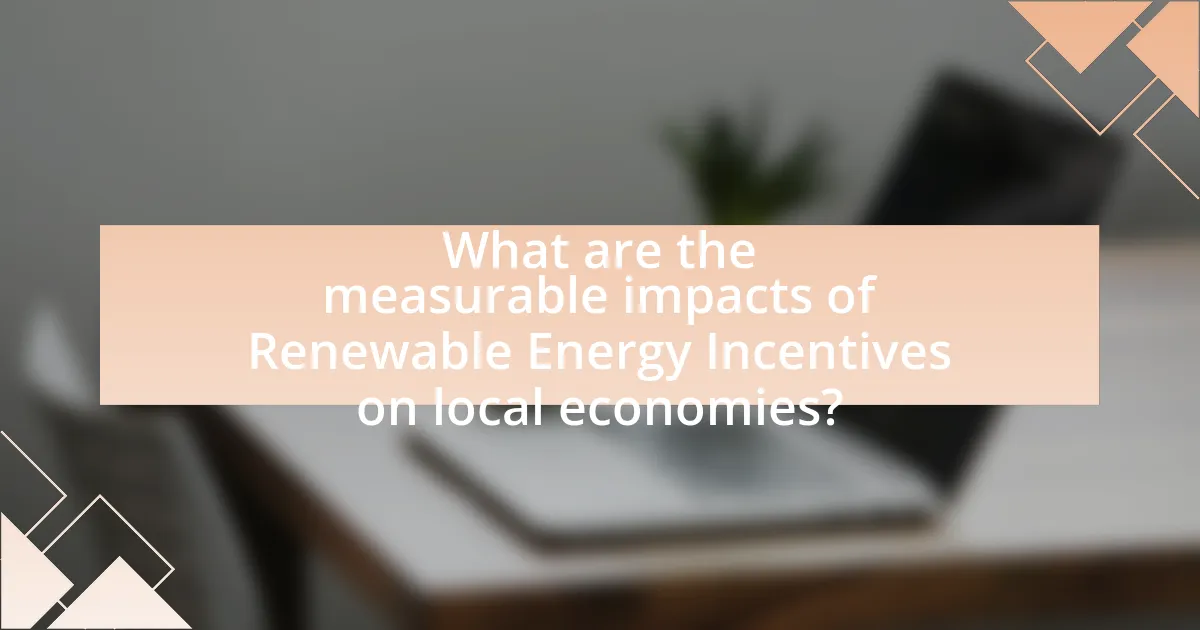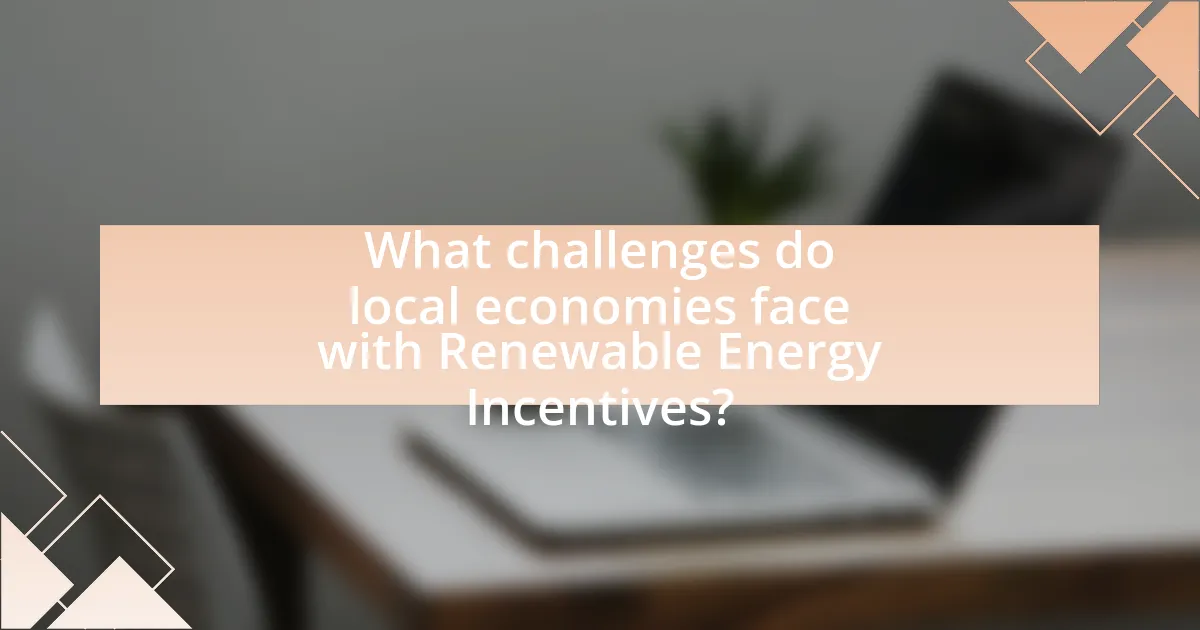Renewable energy incentives are financial and regulatory mechanisms aimed at promoting the adoption of renewable energy sources such as solar, wind, and biomass. These incentives, including tax credits, grants, and feed-in tariffs, significantly reduce the costs associated with renewable energy technologies, making them more competitive with fossil fuels. The article explores how these incentives function within local economies by stimulating investment, creating jobs, and enhancing energy independence. It also discusses the types of incentives available, their impact on local employment rates, business growth, and the challenges faced by local economies in implementing these incentives. Additionally, the article highlights best practices for managing renewable energy incentives effectively and measuring their success in fostering economic development and sustainability.

What are Renewable Energy Incentives and Their Purpose?
Renewable energy incentives are financial and regulatory mechanisms designed to promote the adoption and development of renewable energy sources such as solar, wind, and biomass. Their primary purpose is to reduce the cost of renewable energy technologies, making them more competitive with fossil fuels, thereby accelerating the transition to a sustainable energy system. For example, tax credits, grants, and feed-in tariffs are common incentives that lower the initial investment burden for consumers and businesses, encouraging greater investment in clean energy solutions. According to the International Renewable Energy Agency, such incentives have significantly contributed to the growth of renewable energy capacity worldwide, demonstrating their effectiveness in fostering economic development and job creation in local communities.
How do Renewable Energy Incentives function in local economies?
Renewable energy incentives function in local economies by stimulating investment, creating jobs, and promoting sustainable practices. These incentives, such as tax credits, grants, and rebates, encourage businesses and homeowners to adopt renewable energy technologies like solar and wind power. For instance, a report from the U.S. Department of Energy indicates that every megawatt of solar energy installed creates approximately 5.65 jobs, demonstrating the direct employment benefits of these incentives. Additionally, local economies benefit from increased energy independence and reduced utility costs, which can lead to higher disposable income for residents. Overall, renewable energy incentives drive economic growth while fostering environmental sustainability.
What types of incentives are commonly offered for renewable energy?
Commonly offered incentives for renewable energy include tax credits, grants, rebates, and feed-in tariffs. Tax credits, such as the Investment Tax Credit (ITC) in the United States, allow individuals and businesses to deduct a percentage of the cost of renewable energy systems from their federal taxes, significantly reducing upfront costs. Grants and rebates, often provided by government agencies or utility companies, offer direct financial assistance to offset installation costs. Feed-in tariffs guarantee a fixed payment for energy produced from renewable sources, ensuring a stable revenue stream for producers. These incentives have been shown to increase the adoption of renewable energy technologies, contributing to economic growth and job creation in local communities.
How do these incentives influence investment in renewable energy projects?
Incentives significantly enhance investment in renewable energy projects by reducing financial risks and improving project viability. These incentives, such as tax credits, grants, and feed-in tariffs, lower the initial capital costs and provide stable revenue streams, making renewable energy more attractive to investors. For instance, the Investment Tax Credit (ITC) in the United States allows investors to deduct a percentage of the investment cost from their federal taxes, which has led to a substantial increase in solar energy investments, contributing to a 167% growth in solar capacity from 2016 to 2020. This financial support encourages both large-scale and small-scale projects, fostering innovation and job creation in local economies.
Why are Renewable Energy Incentives important for local economies?
Renewable energy incentives are important for local economies because they stimulate job creation and attract investment. These incentives, such as tax credits and grants, encourage businesses to invest in renewable energy projects, leading to the establishment of new jobs in sectors like solar and wind energy. For instance, a report by the U.S. Department of Energy indicated that the solar industry alone employed over 250,000 workers in 2019, showcasing the significant employment potential linked to renewable energy initiatives. Additionally, local economies benefit from increased energy independence and reduced energy costs, which can enhance overall economic stability and growth.
What economic benefits do these incentives provide to local communities?
Renewable energy incentives provide significant economic benefits to local communities by stimulating job creation and increasing local investment. For instance, the Solar Foundation’s National Solar Jobs Census reported that the solar industry employed over 250,000 workers in the United States in 2019, demonstrating how incentives can lead to substantial employment opportunities. Additionally, these incentives often attract investments in infrastructure and technology, which can enhance local economies. A study by the National Renewable Energy Laboratory found that every megawatt of solar energy installed can generate approximately $1 million in local economic activity, further illustrating the positive impact of renewable energy incentives on community financial health.
How do Renewable Energy Incentives contribute to job creation?
Renewable energy incentives contribute to job creation by stimulating investment in clean energy projects, which leads to the development of new jobs in manufacturing, installation, and maintenance. For instance, the U.S. solar industry employed over 250,000 workers in 2019, a number that has grown significantly due to federal and state incentives like tax credits and grants. These incentives encourage businesses to invest in renewable technologies, resulting in increased demand for skilled labor and creating a ripple effect in local economies through job growth in related sectors.

What are the measurable impacts of Renewable Energy Incentives on local economies?
Renewable energy incentives significantly boost local economies by creating jobs, increasing local investment, and enhancing energy independence. For instance, a study by the National Renewable Energy Laboratory found that every megawatt of solar energy installed creates approximately 5.65 jobs, contributing to local employment rates. Additionally, the American Wind Energy Association reported that wind energy projects have led to over $140 billion in investments in the U.S. since 2008, stimulating local economies through infrastructure development and increased tax revenues. Furthermore, renewable energy initiatives reduce reliance on imported fuels, keeping energy expenditures within the local economy, which can lead to further economic growth.
How do Renewable Energy Incentives affect local employment rates?
Renewable energy incentives positively affect local employment rates by creating jobs in the renewable energy sector. For instance, a study by the National Renewable Energy Laboratory found that for every megawatt of solar power installed, approximately 5.65 jobs are created in installation, manufacturing, and maintenance. Additionally, states that have implemented renewable energy incentives, such as tax credits and grants, have seen significant job growth; for example, California’s solar industry employed over 75,000 workers in 2020, largely due to supportive policies. These incentives stimulate local economies by attracting investments and fostering the development of green technologies, which further enhances job opportunities in the region.
What types of jobs are created through renewable energy projects?
Renewable energy projects create a variety of jobs, including positions in manufacturing, installation, maintenance, and research and development. For instance, the solar energy sector alone has generated over 250,000 jobs in the United States as of 2021, according to the Solar Foundation’s National Solar Jobs Census. These roles encompass solar panel manufacturing, installation technicians, and system maintenance professionals. Additionally, wind energy projects have created jobs in turbine manufacturing and installation, contributing to a workforce of over 100,000 in the U.S. as reported by the American Wind Energy Association. Overall, renewable energy initiatives significantly boost local economies by providing diverse employment opportunities across multiple sectors.
How sustainable are these jobs in the long term?
Jobs created by renewable energy incentives are generally sustainable in the long term due to the growing demand for clean energy solutions and supportive government policies. The International Renewable Energy Agency reported that global renewable energy jobs reached 11.5 million in 2018 and are projected to continue increasing as countries commit to reducing carbon emissions and transitioning to sustainable energy sources. Additionally, investments in renewable energy infrastructure often lead to job creation in manufacturing, installation, and maintenance, which are essential for the ongoing operation of renewable energy systems. This trend is reinforced by the fact that many governments are implementing long-term policies and incentives to promote renewable energy, ensuring job stability and growth in this sector.
What is the impact of Renewable Energy Incentives on local business growth?
Renewable energy incentives significantly boost local business growth by reducing operational costs and encouraging investment in sustainable technologies. These incentives, such as tax credits and grants, lower the financial barriers for businesses to adopt renewable energy solutions, leading to increased energy efficiency and reduced utility expenses. For instance, a study by the National Renewable Energy Laboratory found that businesses utilizing renewable energy sources can save up to 30% on energy costs, which can be reinvested into the local economy. Additionally, the growth of renewable energy sectors creates job opportunities, further stimulating local economic development.
How do these incentives encourage new business ventures?
Renewable energy incentives encourage new business ventures by providing financial support and reducing initial investment risks. These incentives, such as tax credits, grants, and subsidies, lower the cost of entry for startups in the renewable energy sector, making it more feasible for entrepreneurs to launch their businesses. For instance, the Investment Tax Credit (ITC) in the United States allows businesses to deduct a significant percentage of their investment in solar energy systems from their federal taxes, which has led to a surge in solar startups. According to the Solar Energy Industries Association, the solar industry employed over 250,000 workers in 2019, demonstrating how such incentives can stimulate job creation and economic growth in local communities.
What role do local businesses play in the renewable energy sector?
Local businesses play a crucial role in the renewable energy sector by driving innovation, creating jobs, and facilitating the adoption of sustainable practices. They often serve as the primary providers of renewable energy solutions, such as solar panel installation and energy efficiency services, which contribute to local economic growth. According to a report by the U.S. Department of Energy, small businesses accounted for approximately 60% of the jobs created in the renewable energy sector from 2010 to 2020, highlighting their significant impact on employment. Additionally, local businesses often engage in community outreach and education, promoting awareness of renewable energy benefits and encouraging local investment in sustainable technologies. This engagement not only fosters a culture of sustainability but also enhances local economies by keeping energy expenditures within the community.

What challenges do local economies face with Renewable Energy Incentives?
Local economies face several challenges with Renewable Energy Incentives, primarily including financial constraints, market volatility, and regulatory complexities. Financial constraints arise as local governments may struggle to allocate sufficient budgets for implementing and sustaining renewable energy projects, which can limit the effectiveness of incentives. Market volatility can lead to fluctuating energy prices, making it difficult for local businesses to predict costs and investments in renewable technologies. Regulatory complexities often create barriers to entry for smaller local firms, as navigating the various state and federal regulations can be cumbersome and resource-intensive. These challenges can hinder the overall effectiveness of renewable energy incentives in stimulating local economic growth and sustainability.
What are the potential drawbacks of implementing Renewable Energy Incentives?
Implementing Renewable Energy Incentives can lead to several potential drawbacks, including increased financial burden on taxpayers and market distortions. Taxpayer funding for incentives can strain public budgets, as seen in California, where the cost of renewable energy subsidies has reached billions, impacting other essential services. Additionally, these incentives may create market distortions by favoring certain technologies over others, potentially stifling innovation and competition. For instance, the focus on solar and wind energy can divert resources from other promising renewable technologies, limiting overall advancements in the sector.
How can mismanagement of incentives lead to economic issues?
Mismanagement of incentives can lead to economic issues by distorting market signals and encouraging inefficient resource allocation. When incentives are poorly designed or implemented, they can result in overinvestment in certain sectors, such as renewable energy, without corresponding demand, leading to financial losses and market instability. For instance, a study by the International Renewable Energy Agency found that poorly structured subsidies can create market bubbles, where investments exceed sustainable levels, ultimately causing economic downturns in local economies reliant on those sectors.
What are the risks of dependency on renewable energy funding?
Dependency on renewable energy funding poses several risks, including financial instability, market volatility, and potential job losses. Financial instability arises when local economies rely heavily on government subsidies or grants, which can be subject to political changes or budget cuts, leading to abrupt funding shortages. Market volatility can occur if the renewable energy sector becomes overly reliant on external funding sources, making it vulnerable to fluctuations in investment trends and economic conditions. Additionally, if funding is withdrawn or reduced, jobs created in the renewable sector may be at risk, impacting local employment rates and economic growth. These risks highlight the importance of developing a balanced and sustainable approach to renewable energy funding that mitigates dependency.
How can local governments effectively manage Renewable Energy Incentives?
Local governments can effectively manage Renewable Energy Incentives by implementing clear policies, establishing transparent application processes, and providing ongoing support for stakeholders. Clear policies ensure that incentives are aligned with local energy goals and sustainability targets, while transparent application processes facilitate access for businesses and residents, increasing participation rates. Ongoing support, such as educational programs and technical assistance, helps stakeholders navigate the incentives, leading to higher adoption rates of renewable technologies. For instance, a study by the National Renewable Energy Laboratory found that local governments with structured incentive programs saw a 30% increase in renewable energy installations compared to those without such frameworks.
What best practices should be followed for successful implementation?
Successful implementation of renewable energy incentives requires stakeholder engagement, clear communication, and continuous evaluation. Engaging local stakeholders, including community members and businesses, ensures that the incentives meet the specific needs of the local economy. Clear communication about the benefits and processes of the incentives fosters transparency and trust, which are crucial for community buy-in. Continuous evaluation of the program’s effectiveness allows for adjustments based on feedback and changing circumstances, ensuring that the incentives remain relevant and impactful. Research indicates that regions with strong stakeholder involvement and transparent communication see higher rates of adoption and satisfaction with renewable energy initiatives, leading to more robust local economic growth.
How can local economies measure the success of these incentives?
Local economies can measure the success of renewable energy incentives through metrics such as job creation, economic growth, and energy production increases. For instance, tracking the number of new jobs in the renewable energy sector provides a direct indicator of economic impact, with studies showing that for every megawatt of solar energy installed, approximately 5.65 jobs are created. Additionally, analyzing changes in local GDP can reveal the broader economic benefits of these incentives, as regions that adopt renewable energy policies often experience growth rates that exceed national averages. Furthermore, monitoring the increase in renewable energy production, such as the rise in solar or wind energy output, serves as a tangible measure of the effectiveness of these incentives in promoting sustainable energy sources.
What practical steps can communities take to maximize the benefits of Renewable Energy Incentives?
Communities can maximize the benefits of Renewable Energy Incentives by actively engaging in education and outreach programs to inform residents about available incentives and their advantages. By organizing workshops and informational sessions, communities can increase participation in renewable energy projects, leading to higher adoption rates. For instance, a study by the National Renewable Energy Laboratory found that communities with strong educational initiatives saw a 30% increase in solar panel installations compared to those without such programs. Additionally, forming partnerships with local businesses and organizations can facilitate access to resources and funding, further enhancing the implementation of renewable energy solutions.